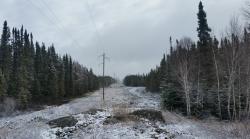How can extremely cold temperatures affect the network, and how can these effects be limited?

 Winter is closing in for networks in the Northern Hemisphere and that typically means cold weather. When powerlines are subjected to extreme weather conditions, including high humidity, freezing temperatures, and ice storms it can result in a build-up of ice. This is important as the extra weight of the ice places significant stress on power lines and infrastructure. This can lead to costly and sometimes quite dramatic damage to power assets.
Winter is closing in for networks in the Northern Hemisphere and that typically means cold weather. When powerlines are subjected to extreme weather conditions, including high humidity, freezing temperatures, and ice storms it can result in a build-up of ice. This is important as the extra weight of the ice places significant stress on power lines and infrastructure. This can lead to costly and sometimes quite dramatic damage to power assets.
Galloping conductors
An example of this is ice related conductor clashing. As ice accumulates on power lines, it forms a teardrop shape. When the wind blows, wires can start to move up and down in an oscillating motion. In essence, the wires encased in ice act like an aerodynamic airplane wing. The movement of the wires occur most commonly in the vertical plane, although horizontal or rotational motion is also possible. This effect is commonly known as "galloping" and it can have serious effect on the powerline.
Galloping can result in wires eventually touching, resulting in a fault or subsequent outage. The increased movement can also cause cross-arms to break, bringing lines to the ground. This, in turn, leads to severe consequences for the network operator, including fines, reputational harm and the cost of repairing the damage.
So, how can these effects be limited?
Prevention
Sufficient phase-to-phase spacing when new lines are designed so that flashovers during galloping are prevented
Prediction
PLS-CADD can be used to model potential overlap of conductors under difference ice weights and sag conditions.
Mitigation
If galloping is occurring on the lines, or PLS-CADD models indicate a risk of conductor clashing as a result of potential galloping, various techniques can be used to remedy this. One strategy is to reduce sag by decreasing span lengths. Either through adding a tower, or replacing with a low sag conductor. Alternatively, inter-phase spacing insulators (mechanical couplings between phases) can be installed in order to maintain phase-to-phase clearances at a pre-determined, acceptable limit, as defined by the PLS-CADD analysis.
The cost of these mitigation techniques must be analyzed against the risk and their likely effectiveness, in order to choose the optimum solution.
NM Group offers PLS-CADD based engineering analysis services for a variety of challenges facing network operators. Our PLS-CADD technicians and electrical engineers are highly experienced and knowledgeable
 For More Information Contact
For More Information ContactNM Group (Network Mapping Inc)
Address:
6880 S. McCarran Blvd., Ste 11
Reno, NV
USA, 89509
www.nmgroup.com





